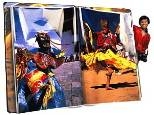CAMBRIDGE, Mass.--Michael Hawley of the MIT Media Lab will make publishing history today with the release of the largest book ever published, as certified by Guinness World Recordsâ„¢.
"Bhutan: A Visual Odyssey Across the Last Himalayan Kingdom" weighs in at more than 130 pounds and stands at five by seven feet, nearly as big as a Ping-Pong table. The book features more than 100 pages of spectacular images of a country often referred to as "the last Shangri-la," and showcases a variety of new digital, photographic and printing techniques.
Hawley, a technology pioneer at the Media Lab and founder of pathbreaking research programs like "Toys of Tomorrow" and "Things that Think," fell in love with the tiny Himalayan kingdom of Bhutan while leading several MIT field expeditions there. Nestled between Nepal, Tibet and India, Bhutan is home to one of the most astonishingly diverse and unspoiled natural and cultural ecologies on earth.
The idea for the book grew out of a desire to use scientific field expeditions to drive better photography. "Every field team, from MIT geologists to the local boy scout troop, feels an obligation to collect and share the best possible record of their work," said Hawley. "But photography can be a real annoyance on expeditions."
Although digital photography has advanced tremendously in recent years, systems are still disorganized and most field teams can't capture a very complete visual record. Much of what comes back from a field expedition languishes on a shelf somewhere, collecting dust.
With seed funding from the Bill and Melinda Gates Foundation and from the MIT/Microsoft iCampus initiative (a five-year alliance between MIT and Microsoft Research), Hawley led four expeditions to Bhutan over the course of four years. Teams of MIT and Bhutanese students, officials and staff flew by helicopter, rode mountain ponies, trekked with packhorses and yaks, and journeyed by caravan on far-flung roads and foot trails across the Bhutanese Himalayas. They had extraordinary assistance from the Royal Government of Bhutan and from Chhundu Travel and Tours.
Hawley's teams were equipped with the latest digital and film photo gear to capture a collective portrait of this remote paradise. Imagery shot by the ensembles of photographers was GPS coded, captioned and stored on pocket disk drives on the spot.
Big Picture Thinking
Back in Cambridge, as the team explored their immense archive of images, Hawley hit upon the idea of showcasing the work in a giant book, letting readers experience the magic of the country firsthand.
"We thought we could allow readers to literally 'step into' this beautiful corner of the world--one which so few people will be blessed to visit," Hawley said. More importantly, he saw the book as a unique way for young Bhutanese to share the values that make their community life special.
Creating the Bhutan book was challenging for a number of reasons. It required designing a whole new production process and a special bookshelf. Each page image is nearly two gigabytes in size, stretching the limits of what computers and printers can normally handle. Each copy of the book uses a roll of paper considerably longer than a football field and requires more than a gallon of ink and 24 hours printing time, all accomplished with HP technology: HP Designjet printers, ultraviolet inks, and fine art media.
Technical teams from Adobe, Amazon.com, Apple, Dell, FedEx, HP, Kodak and Microsoft also helped push this demanding production. To bind the books, Hawley turned to the world's oldest book bindery, Acme Bookbinding of Charlestown, Mass. "Every page in this book is a masterpiece," notes Paul Parisi, president of Acme. "We built the permanent binding it deserves." Acme invented a hand-built binding that combines the strengths of Western-style stitched books with Asian-style fanfolding.
Doing Well by Doing Good
The completed book will be unveiled today at the Explorers Club in New York. It will also be shown at invitation-only events at National Geographic in Washington, Seattle's Asian Art Museum, the Ritz Carlton in San Francisco, and the exclusive Harry Winston Salon in Ginza, Tokyo.
"Bhutan" is a visual and technological tour de force. The stunning imagery loosely follows Hawley's expeditions, conveying the staggering sweep of the country's mountainous terrain and its ancient architecture. Photos of riotously colorful tantric dance festivals and spectacular treks high into the Himalaya are interspersed with scenes of Bhutanese daily life. Many of them feature Choki Lhamo and Gyelsey Loday, two Bhutanese teenagers who helped Hawley's team as photographers and informal guides. The book also includes an illustrated atlas of the country masterfully drawn by artist and author David Macaulay, author of "The Way Things Work," "Cathedral," "Pyramid," "City" and numerous other award-winning books.
A limited edition of 500 copies of Bhutan are being produced, but the book is not being sold in an ordinary sense. It will be offered exclusively to patrons who make a $10,000 or greater contribution to Friendly Planet, a nonprofit 501c3 educational charity. Proceeds will benefit Bhutanese schools, scholars and educational programs. Each copy of the book will be built expressly for the recipient. Amazon.com is the exclusive online outlet for the book and FedEx will provide free shipping to patrons.
The Bhutan project has been an immense effort, but those involved are excited by the results. "We're thrilled to have participated in this endeavor," says Kevin Schofield, director of Microsoft Research University Relations. "The project embodies the ideals of the MIT/Microsoft iCampus initiative--using technology to extend and enhance the learning experience through open collaboration between academia and industry."
For Hawley, opening the book is a visceral experience, like an IMAX movie: "We pushed technology hard, and for a higher purpose, and the images give a taste of an inspiring way of life in a truly special part of the world. All of us feel fortunate to have had the chance to work on this, and the fact that the funds raised will help young students gain an education makes us awfully happy."






